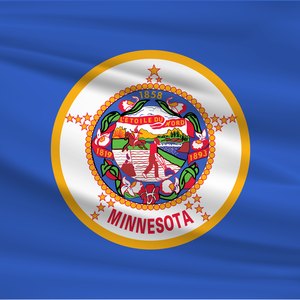
Minnesota is one of 32 states that taxes residents and workers based on graduated rates. The state’s income tax is progressive – lower incomes are taxed at a lesser rate. Understand the filing requirements and processes to determine what type of return you need to file and prepare for the 2021 tax season.
Who Must File Minnesota Income Taxes?
You must generally file a Minnesota income tax return if your income is more than the lowest tax threshold for your filing status. This rule applies to full-year Minnesota residents, to part-year residents and to nonresidents who might have to file a Minnesota state tax return because they work there.
Section 289A.08 of the Minnesota Statutes requires that the Commissioner of Revenue must publish these income levels annually, so keep an eye on the state's website heading into 2022 for the exact 2021 figures in case anything has changed.
You might want to file a Minnesota state tax return under some circumstances even if you’re not technically required to do so. This might be the case if you qualify for certain refundable Minnesota tax credits that could result in cash in your pocket, or if you had any taxes withheld from your paychecks over the course of the year. Filing a return is the only way to get this money back.
What Are the Forms to Use?
The Minnesota tax return for individuals is Form M1. Complete your federal income tax return first because some of the Form M1 calculations depend on your federal taxable income.
You might need other tax forms under some circumstances. Use Form M1X to amend a Minnesota return from a previous year. Submit Form M1CR with your return to claim the state’s tax credit for any income taxes you might have paid to another state for the same tax year.
What Is the Tax Rate in Minnesota?
There are four rates as of 2021. Each rate is the same across all filing statuses, but the spans of income they apply to depend on tax filing status:
- 5.35 percent: This rate applies to incomes of up to $19,905 if you’re married but filing a separate income tax return without your spouse, up to $27,230 if you’re single, to $33,520 if you qualify as head of household and to $39,810 if you’re married and filing jointly.
- 6.8 percent: This rate applies to taxpayers with incomes of $19,905 up to $79,107 if you’re married filing separately, from $27,231 to $89,440 if you’re single, from $33,521 to $134,700 if you’re head of household or from $39,811 to $158,140 if you’re married and filing jointly.
- 7.85 percent: This rate applies to incomes from $79,108 up to $138,100 if you’re married and filing separately, from $89,441 to $166,040 if you’re single, from $134,701 to $220,730 if you’re head of household or from $158,141 to $276,200 for married filing jointly.
- 9.85 percent: Income over the above thresholds is taxed at the highest rate of 9.85 percent: more than $138,100 if you’re married filing separately, more than $166,040 if you’re single, more than $220,730 if you qualify to file as head of household or over $276,200 if you’re married and filing a joint return.
You would pay 5.35 percent on your income up to $27,230 if you’re single and had taxable income of $30,000 in 2021. The balance of your income over $27,230, or $2,770, would be taxed at the 6.8 percent rate.
What Are the Filing Deadline and Extension Process?
Minnesota 2021 individual income tax returns are technically due by April 15, assuming the state doesn’t bump this date back as it did in 2021 in response to the ongoing COVID-19 pandemic and that date doesn't fall on a weekend or holiday. April 15 falls on Good Friday in 2022, so the due date is bumped to Monday, April 18, 2022.
But don't fret because the state offers an automatic extension of time to file. You actually have until Oct. 17, 2022 before you’d have to worry about incurring a late filing penalty. You don’t even have to submit a special form to make the request.
But this deadline and courtesy pertain only to filing your return. Any taxes you owe on that return are still due by the April due date.
Read More: Filing an Extension for Taxes
What Are the Penalties for Late Filing and Underpayment of Taxes?
You’ll be charged penalties and interest if you fail to file your tax return by Oct. 15 or make sufficient payment due by the initial due date in April. But you won’t be charged a penalty or interest if you pay at least 90 percent of the tax due by the spring date, assuming you file your return and pay the entire balance due by Oct. 15.
Further, you can plead your case to avoid paying penalties and interest for late filings and tax payments if you had reasonable cause for missing the dates, such as because you were in the hospital at the time or suffering some other hardship.
Otherwise, the late filing penalty is 5 percent of any tax due and not paid by Oct. 17, 2022. The late payment penalty is 4 percent of any tax due that’s not paid by April 18, 2022. Minnesota will tack on an additional 5 percent of the tax owed after 180 days have passed since you filed your return or April 18, 2022, whichever date is later. Interest accrues as well at the rate of 3 percent as of 2021 and 2022.
Read More: Penalties for a Mistake on Federal Taxes
Where Do I Mail/E-file My Minnesota Return?
Minnesota accepts personal income tax returns both electronically and by mail. In either case, you must include a copy of your federal tax returns and any forms or schedules you filed with the IRS. You can download and print Form M1 from the state’s website, or call 651-296-3781 or 1-800-652-9094 to have paper copies mailed to you.
How Do I Pay Taxes Due?
You can pay any taxes due to the state at Minnesota’s e-Services Payment System. You can pay by credit or debit card, or you can print out a payment voucher to send a check or money order by mail. The check or money order should be made payable to the Minnesota Department of Revenue and should show the last four digits of your Social Security number in the memo field.
Where Can I Check My Minnesota Refund Status?
You can check up on any tax refund you’re expecting using Minnesota’s Where’s My Refund? system. You’ll have to provide your Social Security number, date of birth and the exact amount of the refund you’re expecting. The site will tell you the stage of processing your refund is in.
You can request direct deposit of your refund to your bank account, but Minnesota will only direct deposit up to five income tax refunds to the same account.
What About Minnesota State Taxes If You’re Self-employed?
Self-employed individuals must pay estimated taxes in lieu of having taxes withheld from their paychecks. These payments are generally due by April 15 for income earned during the first quarter of the year, by June 15 for the second quarter, by Sept. 15 by the third quarter, and by Jan. 15 of the following year for the fourth quarter of the tax year. You’re not required to file any separate state tax forms if you’re a sole proprietor.
What About Minnesota State Taxes if You’re a Business?
In addition to filing tax returns, Minnesota corporations must file for a state employer account number unless their only employees are owners or officers who own 25 percent or more of the business. They must also have elected not to be covered by the Minnesota Unemployment Insurance Program.
Otherwise, corporations will also be responsible for paying state unemployment taxes, and they may be liable for sales and use taxes and Federal Insurance Contribution Act (FICA) taxes for their employees as well.
Rates and dates in this article are correct as of publication. But check for any changes at the Minnesota Department of Revenue before you file.
References
- Minnesota Department of Revenue: File an Income Tax Return
- Minnesota Department of Revenue: Where’s My Refund?
- Minnesota Department of Employment and Economic Development: Business Tax Liabilities
- Minnesota Department of Employment and Economic Development: Business Income Tax Returns
- Minnesota Department of Revenue: Who Must File an Income Tax Return?
- Minnesota Department of Revenue: Penalties and Interest for Individuals
- Minnesota Department of Revenue: Search Forms
- Tax Foundation: State Individual Income Tax Rates and Brackets for 2021
- Minnesota Department of Revenue: Income Tax Due Dates
- Minnesota Department of Revenue: Online Services
- Minnesota Legislature: 2021 Minnesota Statutes
Writer Bio
Beverly Bird has been writing professionally for over 30 years. She is also a paralegal, specializing in areas of personal finance, bankruptcy and estate law. She writes as the tax expert for The Balance.

